Resources
We are located at:
North Campus BuildingRoom 120
Western University
1151 Richmond St. N.
London, Ontario
N6A 5B7 Canada
geocollections@uwo.ca
If the walls of Western could talk
BUILDING STONE
We see decorative stone, such as the Whirlpool Sandstone, on the exterior of many of the buildings at Western, including the Biology and Geology building. Due to its resistance to weathering, it makes an excellent exterior cladding stone. However, we often overlook its significance. Rocks are the record of our planet’s past. The sandstone was derived from the erosion of the ancient Appalachian mountain range in eastern North America, about 450 million years ago.
Whirlpool Sandstone has been mined in Ontario from as early as the late 1800s until the 2000s. The Biological and Geological Sciences building (BGS) at Western University was built in 1957 using Whirlpool Sandstone. There were eight Whirlpool Sandstone quarries located between Milton and Inglewood, Ontario, that were the likely source of the Whirlpool Sandstone used to build BGS and several other buildings on campus. Local variations in colour of the Whirlpool sandstone range from grey to pink to dark brown. The grey variety was a popular building stone in Southern Ontario, and was also used for buildings at McMaster University’s campus in the 1920s. The darker brown variety is rarer and was used to build the Provincial Parliament building in Toronto.

Many buildings on campus are clad in Whirlpool Sandstone. This picture from 1957 shows stacks of cut blocks of Whirlpool Sandstone being used to construct Middlesex College. The image is from the London Free Press collection of photographic negatives/Western Archives.
SEDIMENT SOURCE
Around 500 million years ago, the Iapetus Ocean - which existed between Laurentia and Gondwana - began to close as several continental masses converged. The closing of Iapetus can be seen in the following paleogeographic reconstructions. A major consequence of plate convergence was the Acadian Orogeny which formed the Appalachian Mountains that extend from Eastern Canada into the United States. Over time, some of these sediments, eroded from the rising Appalachians, were deposited in what is now southern Ontario.
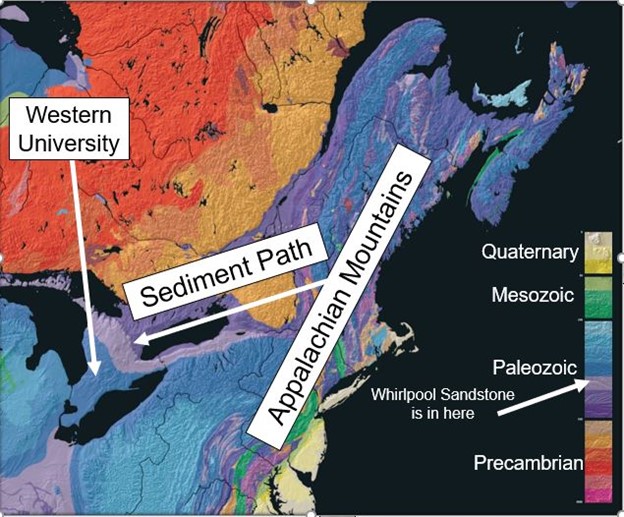
This map of Eastern Canada and the United States shows the expected path of sediment deposition from the Appalachian Mountains to what is now Southern Ontario. The Whirlpool Sandstone would be included in the light purple colour on the map. This image was modified from the North American Tapestry of Time map compiled by the USGS in 2003.
DEPOSITIONAL ENVIRONMENT
The Whirlpool Sandstone formed during the early years of the Silurian Period, about 444.0 -419.0 million years ago. The Whirlpool consists of two sections, Upper and Lower.
The Upper Whirlpool Sandstone is interpreted to have formed in a near-shore shallow marine environment, due to the presence of trace fossils, body fossils, and organic microfossils of Silurian marine organisms. Skolithos and Cruziana ichnofacies (burrows formed by marine worms), along with cross-bedding and ripples are common in marine depositional environments. These features are all found in the Upper Whirlpool Sandstone.
The Lower Whirlpool Sandstone is interpreted to have formed in a littoral or terrestrial environment. The Lower Whirlpool contains abundant evidence of unidirectional flow and of dramatic changes in water depth and flow velocity; the unit also lacks trace fossils. This evidence strongly suggests deposition in shallow braided rivers, subject to flash flooding.
This stratigraphy suggests that sea level was rising during the formation of the Whirlpool Sandstone in the Early Silurian.
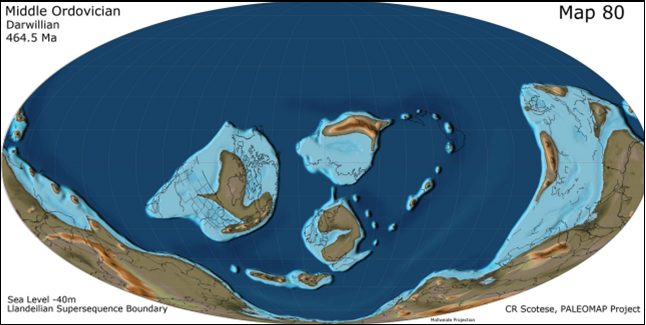
Reconstruction of the distribution of continents and smaller landmasses during the Middle Ordovician Period, about 464 million years ago. The Appalachian mountain belt was starting to form on the eastern margin of North America, shedding sand and mud that formed the Queenston Formation. (Map from Scotese, 2014, Atlas of Silurian and Middle to Late Ordovician Paleogeographic Maps)
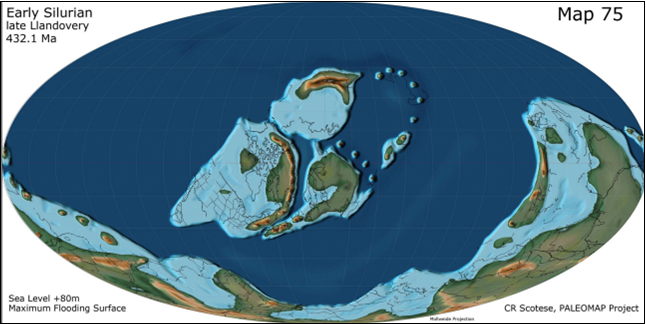
Reconstruction of the distribution of continents during the Early Silurian, about 432 million years ago. The growing Appalachian mountain range on the eastern margin of North America was eroded by rivers that carried sand westward to form the Whirlpool Sandstone. (Map from Scotese, 2014, Atlas of Silurian and Middle to Late Ordovician Paleogeographic Maps)
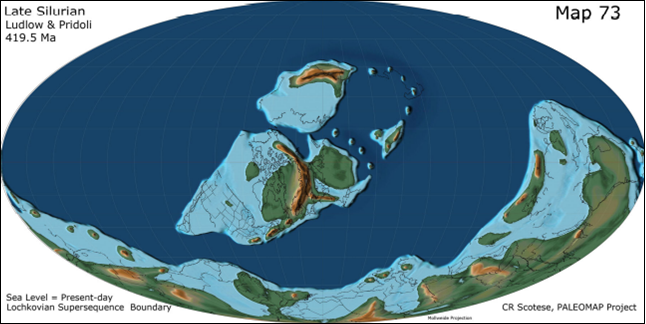
By the Late Silurian, about 419 million years ago, sea-level rise flooded what is now southern Ontario, leading to deposition of fossil-bearing limestones that form the upper parts of the rock succession in the Niagara Escarpment. (Map from Scotese, 2014, Atlas of Silurian and Middle to Late Ordovician Paleogeographic Maps)
WHIRLPOOL SANDSTONE
The specimens on display in the Biology and Geology Building on the first floor across from room 1056 illustrate the stratigraphic relations of the Whirlpool Sandstone. The differing rock types, including dolostone, sandstone and limestone record changes between terrestrial and shallow marine depositional environments. These environmental changes were controlled by alternate tectonic uplift and subsidence, and by changes in climate and sea-level. This complex sedimentary history is recorded by rocks exposed in the Niagara Gorge.

Stratigraphic chart of part of the Upper Ordovician (Ord) and Lower Silurian rocks in southern Ontario (modified from Carter et al. 2019, GSC Open File 8618).
COMPOSITION
The Whirlpool Sandstone is composed almost entirely of quartz grains, with traces of feldspar, tourmaline, garnet and zircon, derived from granitic rocks in the Appalachian Mountains. Plans are in place to date some of the zircon grains as a possible confirmation of their Appalachian origins.
WHERE DID THE NAME WHIRLPOOL COME FROM?
Have you ever been to Niagara Falls? North of Niagara Falls there is a section of the Niagara River that is famous for having a large whirlpool. The Whirlpool Sandstone is the bedrock at the bottom of this section in the Niagara River! If you want to visit the whirlpool, you can go for a hike at the Niagara Glen Nature Center (which also has great views of the overlying rock units), or on several tourist attractions such as cable car or boat rides.
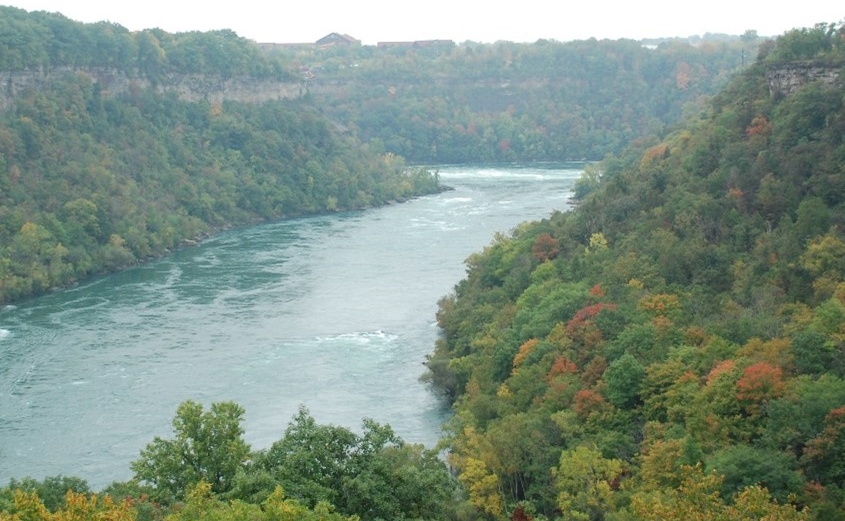
ACKNOWLEDGEMENTS
This display was created by students Stephanie Kobylinski and Dana Halay, with assistance from Dr. Alysha McNeil, Ian Nicklin, Dr. Desmond Moser, and Dr. Guy Plint. Specimen mount created by Jon Jacobs.

